Perhaps there are some on the East Coast of Australia who look across to the isolated West with a slight patronising sense of pathos. Western Australia can’t even take part in the apparently ‘National’ Energy Market (NEM). However, yesterday Western Australia’s (WA) Energy Transformation Taskforce (ETT) delivered its inaugural Whole of System Plan (WOSP), which expects to triple renewable energy generation by 2040. This is all to say that there is nothing pitiable about WA’s isolation, it’s on its own because it’s way out in front.
WA’s principle power system, the South West Interconnected System (SWIS), is one of the largest isolated power systems in the world, but this isolation is no weakness. In fact, while a cacophony of actors dispute and tussle over AEMO’s Integrated System Plan (ISP) for the rest of the country (with the Federal Government actively shirking the plan), WA is getting on with the job.
The WOSP models four scenarios (Cast Away, Groundhog Day, Techtopia, Double Bubble) in which changes in demand, technology, and the economy, might shape the way we utilise electricity in the future in order to guide our investments. Across all models, the WOSP shows renewable generation tripling by 2040, with a particularly strong uptake in wind, the continuation of traditional energy displacement by rooftop solar, and the growing part to be played by battery storage.
The WOSP itself follows on from the Government’s release of the Distributed Energy Resources (DER) Roadmap, demonstrating a level of foresight in Western Australia that makes the Federal Government look about as prudent as a dog chasing a car. Indeed, instead of avoiding the pertinent questions of our near future, the WOSP has sought to answer them. Questions concerning the evolution of mixing generation and where new generation is likely to be located, what investment new generation and technology would require, how big of a role will customer-owned generation be, the role of energy storage, and the reliance on brown and black fossil fuels going forward?
According to ETT Chair, Stephen Edwell, “The Taskforce has made ten high-level observations from the modelling. Overall, my perspective is that the WOSP, in conjunction with the implementation of the DER Roadmap actions and the new market design, demonstrates the SWIS will have the market structures to accommodate high levels of renewable energy provided we continue to plan and manage the transition.”
The “ten high-level observations” Edwell mentions include, as previously mentioned, the tripling of renewable energy generation with the expectation that it reaches 70% of generation by 2040, that rooftop solar will not only continue to displace coal but also large-scale solar, that emissions will reduce despite increased end-user demand, that storage and gas facilities will firm the grid, and the continuing decline of coal-fired generation across all scenarios.
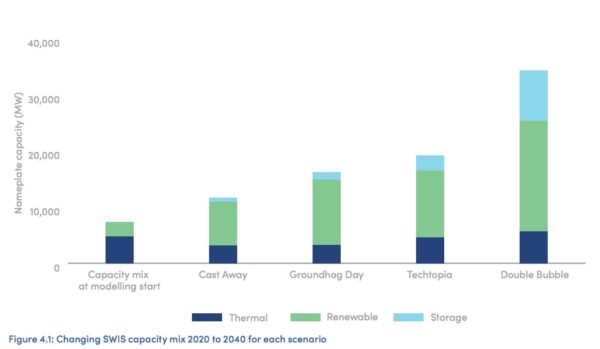
WA Energy Minister Bill Johnston called WOSP “the most comprehensive modelling study ever undertaken into the future of WA’s electricity system and it will support our transition to low-cost electricity.” So let’s see what’s in this whole of system plan.
Rooftop Solar & ESS
Currently, renewable generation comprises 34% of installed capacity in WA with 2,494 MW, of which more than half, 1,291 MW, is rooftop PV. The WOSP modelling sees rooftop PV continuing into ascendency because, firstly, there is no market cost for installing new rooftop solar, they are paid for by customers. And secondly, because the surplus energy produced by the solar systems “spills out into the network throughout the day, meaning it is effectively ‘dispatched’ ahead of all other capacity and displaces all forms of large-scale generation, subject to ESS requirements on the system.”
This continuing rise fits nicely into the WA Government’s previously released DER Roadmap, which seeks to enable rooftop PV to be better integrated into the system. The interplay of the two plans will be important considering WOSP is assumed to increase by between 1 GW and 4 GW by 2030.
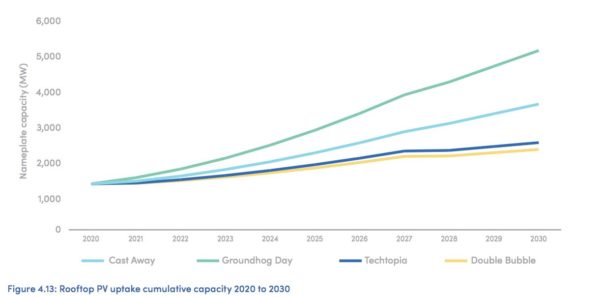
Moreover, the more rooftop solar in the system, the more necessary the proliferation of energy storage systems (ESS), such as home batteries. “Our State is embracing renewable generation,” said Johnston, “with one in three households having rooftop solar panels, this signifies that battery storage will play an important role in our future.” The WOSP modelling sees ESS as having great opportunity over the next two decades, showing large-scale storage, specifically 2-hour and 4-hour duration battery storage, will play an increased role in the SWIS.
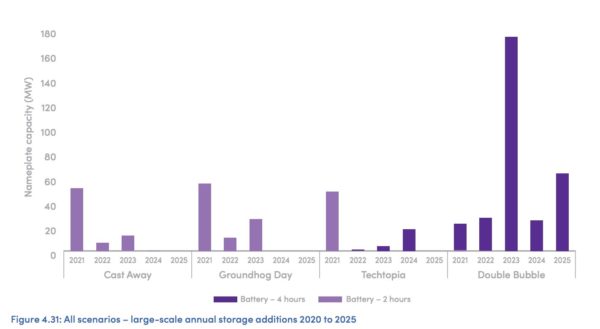
Indeed, overall, the models select battery storage over other ESS technologies for WA. And while the 2-hour batteries are seen in the models over the next decade, the following decade shows a preference for the 4-hour duration batteries as it is assumed their costs will decrease substantially by 2030.
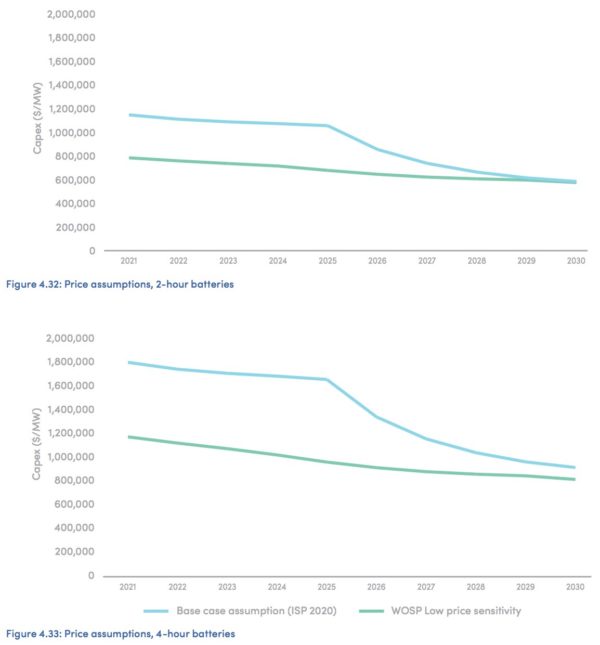
Emissions reduction, but not eradication
Despite the modelling showing ongoing reductions in emissions, the plans do not follow AEMO’s ISP by predicting the complete eradication of coal by 2040, but neither do the plans hold out high hopes for anything other than a terminal decline in the future.
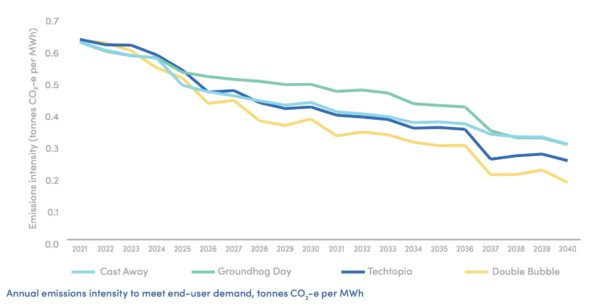
Image: Government of Western Australia
Indeed, the the lower demand scenarios, between 132 MW and 500 MW of coal plan capacity would no longer feature in the lowest cost to supply from 20205 over and above the closure of Muja C in 2024.
Nevertheless, the models still show coal-fired power playing a part over the next 20 years, even as it shrinks in competition with cheaper, cleaner technologies.
Finally, though WOSP doesn’t exactly hide its gas-fired plans, it doesn’t exactly advertise these plans either. This is probably wise, considering the gas-storm currently hovering over the east coast since the Morrison Government announced it had lost its marbles, or worse, found them in the gas sector’s pocket. Nevertheless, it seems WOSP’s models see “new flexible gas-fired facilities” in the state’s future as gas is set to continue playing a leading role in the system’s capacity makeup.
Of course, gas remains the largest capacity provider of large-scale generation, accounting for 52%, a figure which could increase considering two of the WOSP models (Cast Away and Groundhog Day), assume between 667 MW and 867 MW of new gas-fired generation is required by 2030.
Despite this, Clean Energy Council (CEC) Chief Executive Kane Thornton welcomed the WOSP, saying that WA “is making tremendous gains in its efforts to increase the role of renewable energy and this plan will ensure the transition is well-managed and least-cost.”
According to Thornton, WA “has traditionally lagged behind the eastern states when it comes to renewable energy, but it’s really starting to make up ground…resulted in a rapid transformation across both small- and large-scale renewable energy and, most recently, plans were unveiled for a 100 MW big battery to help stabilise the state’s energy needs.”
This content is protected by copyright and may not be reused. If you want to cooperate with us and would like to reuse some of our content, please contact: editors@pv-magazine.com.
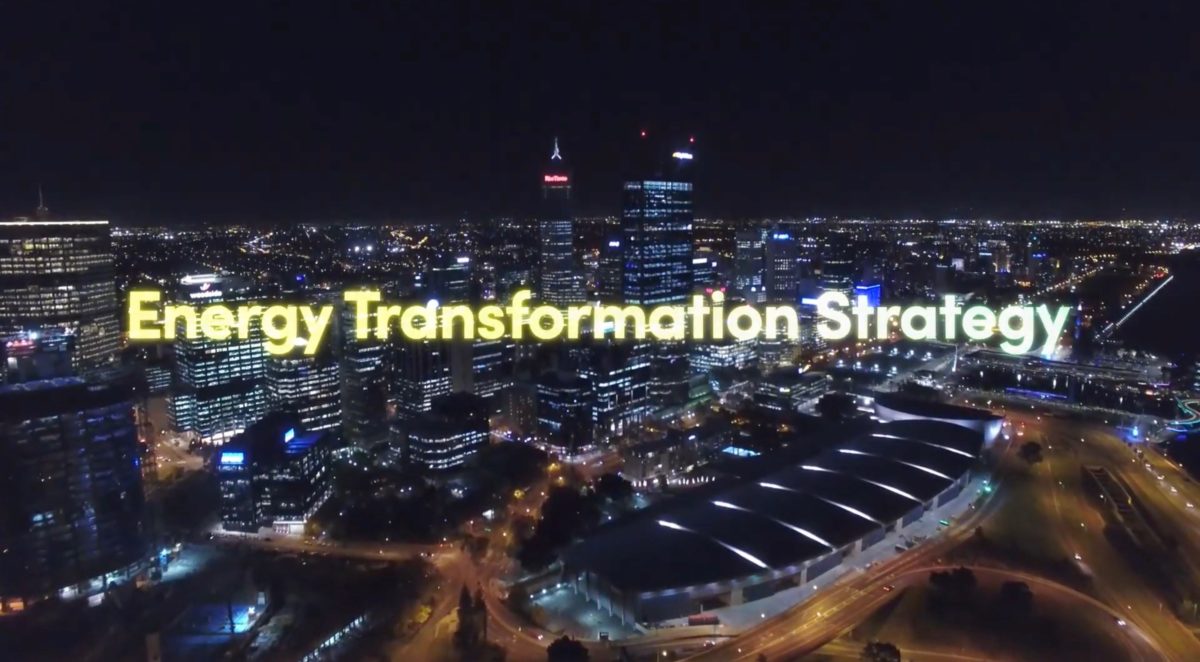








By submitting this form you agree to pv magazine using your data for the purposes of publishing your comment.
Your personal data will only be disclosed or otherwise transmitted to third parties for the purposes of spam filtering or if this is necessary for technical maintenance of the website. Any other transfer to third parties will not take place unless this is justified on the basis of applicable data protection regulations or if pv magazine is legally obliged to do so.
You may revoke this consent at any time with effect for the future, in which case your personal data will be deleted immediately. Otherwise, your data will be deleted if pv magazine has processed your request or the purpose of data storage is fulfilled.
Further information on data privacy can be found in our Data Protection Policy.